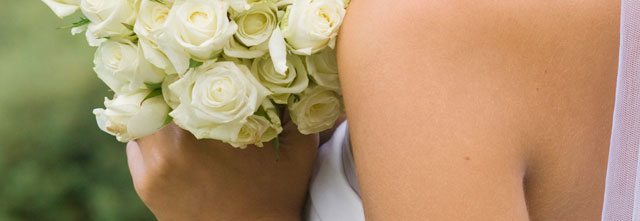When it comes to marriage ceremonies, an increasing number of couples are planning unique events that express themselves, rather than what strict tradition dictates. And that means brides can profess their love in gowns as individual as they are.
Randy Fenoli, Kleinfeld’s fashion director, star of TLC’s “Say Yes To The Dress” sand author of It’s All About The Dress, says today’s brides take a very personal approach to their weddings — and their gowns.
“Brides are definitely setting their own trends today by choosing gowns that reflect their personality, style and taste level,” Fenoli says. “The venue seems to be less of a factor. I’ve seen brides wear formal gowns on the beach and in a barn, as well as brides getting married in a formal church who choose a simple sheath. Yesterday’s rules just don’t apply anymore.”
The most important wedding gown features for today’s brides are fit (94%) and style (93%), followed by price (89%), comfort (88%) and fiber content (57%), according to the Cotton Incorporated Lifestyle MonitorTM Survey.
While “silks are the fabrics most associated with a bridal gown,” according to Fenoli, Monitor data indicate that many brides are willing to say “I do” to cotton.
Fifty eight percent of women say they prefer their wedding gown to be made of silk, followed by cotton (13%), polyester (7%), rayon (7%), and linen (4%). However, almost 7 out of 10 women (69%) would consider purchasing a wedding gown with cotton as the primary fabric, citing comfort (32%), “looks good” (24%) and breathability (10%) as reasons.
At the International Bridal Show in New York, cotton gowns were located among the better, higher-end labels. “A cotton gown usually appeals to a more sophisticated bride who wants something completely unique, which is found in the more couture labels,” Fenoli says.
Designer Claire Pettibone agrees. “It may be that the lower-end market perceives satin, shiny fabrics as being more expensive. A more refined client appreciates subtle details and recognizes that cotton is a quality fabric and a lovely addition to the silks and other fine fabrics found in designer collections.”
Pettibone says there have been changes in the bridal world since she introduced cotton to her line about eight years ago.
“It used to be the non-traditional bride that loved the collection. But now, getting married in a garden or field is very much in fashion. So it has kind of flipped that idea of tradition on its head,” she says. “I always found people’s concept of ‘tradition’ to be so limited anyway. I have brides who get married in all styles of weddings — from forests and beaches, to castles and lofts. The bride wants to create a mood and express her individual style, and often a gown with cotton elements does just that.”
Priscilla Chan, who made headlines for marrying Facebook founder Mark Zuckerberg, wore one of Pettibone’s designs down the aisle in a surprise ceremony last weekend.
The Wedding Report shows that over the last three years, desire for a traditional wedding has declined more than 30%.
“Yes, couples are moving away from church weddings to more unique locations,” says Shane McMurray, CEO and founder of The Wedding Report.
The Wedding Report shows a jump in interest in destination (+8%), unique (+6%) and “green” or eco-friendly (+3%) weddings since 2008.
The Cotton Bride’s Chris Kole, designer, says modern brides are much more likely to be unconstrained by convention and instead make decisions by what appeals to them as individuals — from both emotional and practical perspectives.
[quote]
Kole, who creates both elaborate and understated cotton gowns, says that whether in a house of worship or outdoors, bridal is trending toward a period look.
“Trendwise, we are noticing more and more of our brides looking for vintage elements and opting for cleaner, simpler design over a dress that has excess beading or superfluous detail,” Kole says.
On average, women are willing to pay about $809 for the “perfect” wedding gown, the Monitor finds. Among women earning $75,000 or more, the figure increases to $1,083.
At Fancy Bridal New York, the idea is vintage “Sunday Best On Your Wedding Day,” for brides who prefer wedding dresses over gowns, says Gregory Nato, creative director and designer.
“We started to research bridal traditions of the past and found cotton played a huge role,” Nato says. “Amazing cotton fabrics had been used for years in creative ways to produce really lovely bridal dresses.” Spring/summer styles include cotton organdy, dotted Swiss, cotton crochets and silk cotton blends.
International brides from places like the U.K., Denmark and Australia have helped grow Fancy’s cotton styles, “because there is a great appreciation for ‘old world’ techniques (pleating details, hand-crocheting, etc.) in these markets.”
The Jim Hjelm Blush collection includes cotton each season, says Hayley Paige, designer.
“Aesthetically, cotton has an attractive casual elegance about it,” Paige says. “It complements brides looking for something more organic and comfortable. The beauty of cotton is in the texture itself, so I gravitate to the subtler styles that are better for bridal silhouettes.”
She says interest in cotton gowns has grown a bit over the years.
“Now more than ever, brides are embracing uniqueness, but this doesn’t necessarily mean they don’t want to maintain a timeless or traditional concept.”
